Input interpretation

H_2SO_4 sulfuric acid + BeO beryllium oxide ⟶ H_2O water + BeSO_4 beryllium sulfate
Balanced equation
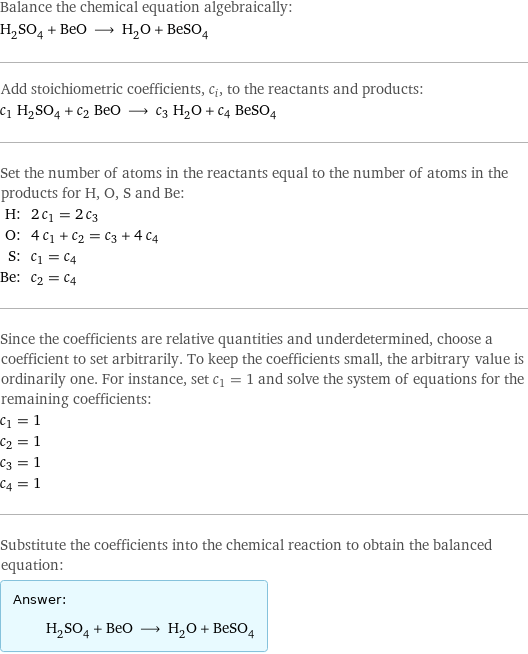
Balance the chemical equation algebraically: H_2SO_4 + BeO ⟶ H_2O + BeSO_4 Add stoichiometric coefficients, c_i, to the reactants and products: c_1 H_2SO_4 + c_2 BeO ⟶ c_3 H_2O + c_4 BeSO_4 Set the number of atoms in the reactants equal to the number of atoms in the products for H, O, S and Be: H: | 2 c_1 = 2 c_3 O: | 4 c_1 + c_2 = c_3 + 4 c_4 S: | c_1 = c_4 Be: | c_2 = c_4 Since the coefficients are relative quantities and underdetermined, choose a coefficient to set arbitrarily. To keep the coefficients small, the arbitrary value is ordinarily one. For instance, set c_1 = 1 and solve the system of equations for the remaining coefficients: c_1 = 1 c_2 = 1 c_3 = 1 c_4 = 1 Substitute the coefficients into the chemical reaction to obtain the balanced equation: Answer: | | H_2SO_4 + BeO ⟶ H_2O + BeSO_4
Structures

+ ⟶ +
Names

sulfuric acid + beryllium oxide ⟶ water + beryllium sulfate
Reaction thermodynamics
Enthalpy
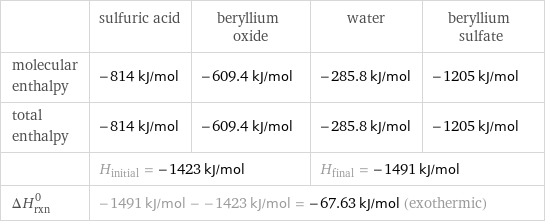
| sulfuric acid | beryllium oxide | water | beryllium sulfate molecular enthalpy | -814 kJ/mol | -609.4 kJ/mol | -285.8 kJ/mol | -1205 kJ/mol total enthalpy | -814 kJ/mol | -609.4 kJ/mol | -285.8 kJ/mol | -1205 kJ/mol | H_initial = -1423 kJ/mol | | H_final = -1491 kJ/mol | ΔH_rxn^0 | -1491 kJ/mol - -1423 kJ/mol = -67.63 kJ/mol (exothermic) | | |
Gibbs free energy
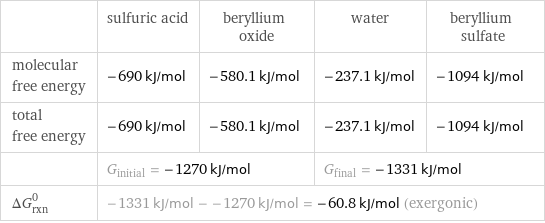
| sulfuric acid | beryllium oxide | water | beryllium sulfate molecular free energy | -690 kJ/mol | -580.1 kJ/mol | -237.1 kJ/mol | -1094 kJ/mol total free energy | -690 kJ/mol | -580.1 kJ/mol | -237.1 kJ/mol | -1094 kJ/mol | G_initial = -1270 kJ/mol | | G_final = -1331 kJ/mol | ΔG_rxn^0 | -1331 kJ/mol - -1270 kJ/mol = -60.8 kJ/mol (exergonic) | | |
Equilibrium constant
![Construct the equilibrium constant, K, expression for: H_2SO_4 + BeO ⟶ H_2O + BeSO_4 Plan: • Balance the chemical equation. • Determine the stoichiometric numbers. • Assemble the activity expression for each chemical species. • Use the activity expressions to build the equilibrium constant expression. Write the balanced chemical equation: H_2SO_4 + BeO ⟶ H_2O + BeSO_4 Assign stoichiometric numbers, ν_i, using the stoichiometric coefficients, c_i, from the balanced chemical equation in the following manner: ν_i = -c_i for reactants and ν_i = c_i for products: chemical species | c_i | ν_i H_2SO_4 | 1 | -1 BeO | 1 | -1 H_2O | 1 | 1 BeSO_4 | 1 | 1 Assemble the activity expressions accounting for the state of matter and ν_i: chemical species | c_i | ν_i | activity expression H_2SO_4 | 1 | -1 | ([H2SO4])^(-1) BeO | 1 | -1 | ([BeO])^(-1) H_2O | 1 | 1 | [H2O] BeSO_4 | 1 | 1 | [BeSO4] The equilibrium constant symbol in the concentration basis is: K_c Mulitply the activity expressions to arrive at the K_c expression: Answer: | | K_c = ([H2SO4])^(-1) ([BeO])^(-1) [H2O] [BeSO4] = ([H2O] [BeSO4])/([H2SO4] [BeO])](../image_source/23308ccfa17000c4a7d3b5f3a7652455.png)
Construct the equilibrium constant, K, expression for: H_2SO_4 + BeO ⟶ H_2O + BeSO_4 Plan: • Balance the chemical equation. • Determine the stoichiometric numbers. • Assemble the activity expression for each chemical species. • Use the activity expressions to build the equilibrium constant expression. Write the balanced chemical equation: H_2SO_4 + BeO ⟶ H_2O + BeSO_4 Assign stoichiometric numbers, ν_i, using the stoichiometric coefficients, c_i, from the balanced chemical equation in the following manner: ν_i = -c_i for reactants and ν_i = c_i for products: chemical species | c_i | ν_i H_2SO_4 | 1 | -1 BeO | 1 | -1 H_2O | 1 | 1 BeSO_4 | 1 | 1 Assemble the activity expressions accounting for the state of matter and ν_i: chemical species | c_i | ν_i | activity expression H_2SO_4 | 1 | -1 | ([H2SO4])^(-1) BeO | 1 | -1 | ([BeO])^(-1) H_2O | 1 | 1 | [H2O] BeSO_4 | 1 | 1 | [BeSO4] The equilibrium constant symbol in the concentration basis is: K_c Mulitply the activity expressions to arrive at the K_c expression: Answer: | | K_c = ([H2SO4])^(-1) ([BeO])^(-1) [H2O] [BeSO4] = ([H2O] [BeSO4])/([H2SO4] [BeO])
Rate of reaction
![Construct the rate of reaction expression for: H_2SO_4 + BeO ⟶ H_2O + BeSO_4 Plan: • Balance the chemical equation. • Determine the stoichiometric numbers. • Assemble the rate term for each chemical species. • Write the rate of reaction expression. Write the balanced chemical equation: H_2SO_4 + BeO ⟶ H_2O + BeSO_4 Assign stoichiometric numbers, ν_i, using the stoichiometric coefficients, c_i, from the balanced chemical equation in the following manner: ν_i = -c_i for reactants and ν_i = c_i for products: chemical species | c_i | ν_i H_2SO_4 | 1 | -1 BeO | 1 | -1 H_2O | 1 | 1 BeSO_4 | 1 | 1 The rate term for each chemical species, B_i, is 1/ν_i(Δ[B_i])/(Δt) where [B_i] is the amount concentration and t is time: chemical species | c_i | ν_i | rate term H_2SO_4 | 1 | -1 | -(Δ[H2SO4])/(Δt) BeO | 1 | -1 | -(Δ[BeO])/(Δt) H_2O | 1 | 1 | (Δ[H2O])/(Δt) BeSO_4 | 1 | 1 | (Δ[BeSO4])/(Δt) (for infinitesimal rate of change, replace Δ with d) Set the rate terms equal to each other to arrive at the rate expression: Answer: | | rate = -(Δ[H2SO4])/(Δt) = -(Δ[BeO])/(Δt) = (Δ[H2O])/(Δt) = (Δ[BeSO4])/(Δt) (assuming constant volume and no accumulation of intermediates or side products)](../image_source/46137f13adfd19c32afa792c4e23732b.png)
Construct the rate of reaction expression for: H_2SO_4 + BeO ⟶ H_2O + BeSO_4 Plan: • Balance the chemical equation. • Determine the stoichiometric numbers. • Assemble the rate term for each chemical species. • Write the rate of reaction expression. Write the balanced chemical equation: H_2SO_4 + BeO ⟶ H_2O + BeSO_4 Assign stoichiometric numbers, ν_i, using the stoichiometric coefficients, c_i, from the balanced chemical equation in the following manner: ν_i = -c_i for reactants and ν_i = c_i for products: chemical species | c_i | ν_i H_2SO_4 | 1 | -1 BeO | 1 | -1 H_2O | 1 | 1 BeSO_4 | 1 | 1 The rate term for each chemical species, B_i, is 1/ν_i(Δ[B_i])/(Δt) where [B_i] is the amount concentration and t is time: chemical species | c_i | ν_i | rate term H_2SO_4 | 1 | -1 | -(Δ[H2SO4])/(Δt) BeO | 1 | -1 | -(Δ[BeO])/(Δt) H_2O | 1 | 1 | (Δ[H2O])/(Δt) BeSO_4 | 1 | 1 | (Δ[BeSO4])/(Δt) (for infinitesimal rate of change, replace Δ with d) Set the rate terms equal to each other to arrive at the rate expression: Answer: | | rate = -(Δ[H2SO4])/(Δt) = -(Δ[BeO])/(Δt) = (Δ[H2O])/(Δt) = (Δ[BeSO4])/(Δt) (assuming constant volume and no accumulation of intermediates or side products)
Chemical names and formulas
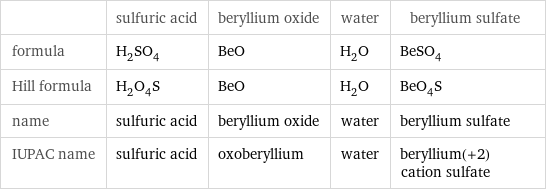
| sulfuric acid | beryllium oxide | water | beryllium sulfate formula | H_2SO_4 | BeO | H_2O | BeSO_4 Hill formula | H_2O_4S | BeO | H_2O | BeO_4S name | sulfuric acid | beryllium oxide | water | beryllium sulfate IUPAC name | sulfuric acid | oxoberyllium | water | beryllium(+2) cation sulfate
Substance properties
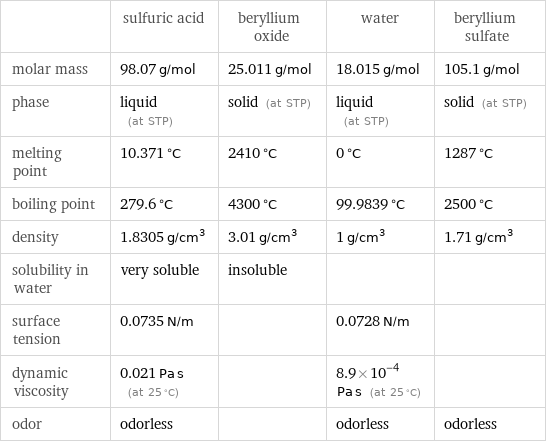
| sulfuric acid | beryllium oxide | water | beryllium sulfate molar mass | 98.07 g/mol | 25.011 g/mol | 18.015 g/mol | 105.1 g/mol phase | liquid (at STP) | solid (at STP) | liquid (at STP) | solid (at STP) melting point | 10.371 °C | 2410 °C | 0 °C | 1287 °C boiling point | 279.6 °C | 4300 °C | 99.9839 °C | 2500 °C density | 1.8305 g/cm^3 | 3.01 g/cm^3 | 1 g/cm^3 | 1.71 g/cm^3 solubility in water | very soluble | insoluble | | surface tension | 0.0735 N/m | | 0.0728 N/m | dynamic viscosity | 0.021 Pa s (at 25 °C) | | 8.9×10^-4 Pa s (at 25 °C) | odor | odorless | | odorless | odorless
Units
